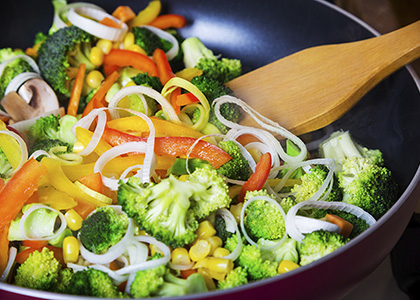
Cook Like a Chef! 9 Cooking Methods Explained
By Kristen DeAngelis
Have you transitioned off of your Reboot and are looking to incorporate plant-based meals as a regular part of your diet? The struggle in the transition may be lack of confidence in the kitchen. A recipe that lists “sautéed greens”, “blanched brussels sprouts”, or “roasted veggies” can seem daunting without knowledge of what these terms mean. Choosing the right cooking method can make a healthy lifestyle sustainable, and cooking more fun. It impacts the appearance, texture, flavor, aroma, and even nutrition quality of your plant food! If it’s not juiced, blended or eaten raw, here are 9 basic cooking methods to help you enjoy the beauty of plant-based eating.
1. Grill
Grilling involves an open flame where the food is cooked from the bottom up. To pre-heat your grill, turn to medium-high heat and keep the lid covered until hot. To cook, add veggies directly to the griddle, or use vegetable skewers or a grilling grate.Try adding grilled peppers and onions to a sandwich, Portobello mushrooms as a meat patty substitute, or try adding grilled peppers and onions to a sandwich, Portobello mushrooms as a meat patty substitute, or grilled veggie skewers for a main meal. Add whole fruit like pineapple rings or halved peaches, to the grill for a delicious and beautiful char-marked dessert. Checkout these 5 tips for healthy grilling.
2. Roast
Roasting is similar to baking, and refers to vegetables or animal proteins cooked in an oven. Roasted root vegetables like sweet potatoes, beets, turnips and carrots, are easy to make and turn into a delicious and tender meal, or can be added to a healthy and vibrant Winter Kale Salad.Roasting does not use liquid and retains vitamins that are otherwise lost in methods like boiling. Peel and chop vegetables to uniform sizes (cubed or sliced) and place on an uncovered baking pan. Bake in a pre-heated oven at 350F (180 C) about 30 minutes or until cooked (when you can easily pierce the veggie with your fork).
3. Broil
Broiling uses high heat to slightly brown the top of a food item. This method produces a crispy, browned finish like these Yam “Fries”. Set your oven to the broil setting, and watch food carefully so that it does not burn. Broiling can even be used for desserts like broiled grapefruit!
4. Steam
Vegetables can be cooked by using the high heat of steam from a small amount of water. In a small pan, add vegetables to a steamer basket over 1-2” of boiling water and cook to desired tenderness. Did you know, steaming actually retains more nutrients than boiled? This 2007 Study showed that boiling led to a significant loss of the cancer fighting glucosinolates in broccoli (77% loss), Brussels sprouts (58% loss) and cauliflower (75% loss), whereas when they were steamed there was no significant nutrient loss.
5. Sauté
Sautéed foods are cooked for a short amount of time in a thin layer of fat. Using a frying pan, add a thin layer (1-2 tbsp) of fat (olive oil or coconut oil). Slightly cook your foods in the oil over a stovetop on medium-high heat. The small amount of fat can actually increase nutrient absorption for some vegetable likes carrots, which contain Vitamin A, a fat-soluble vitamin. Sautéing allows you to control the desired tenderness of your foods. Sautéing is an easy way to mix together lots of veggies, spices and herbs for a robust and flavorful meal. Try this easy Caprese Kale Sauté.
6. Simmer
Simmering allows ingredients to cook on a very low heat in a saucepan of liquid, broth, or water until tender. This method allows the full flavors of ingredients to be incorporated together. You will begin to see tiny bubbles appear on the surface. Try out these tips from TheKitchn for simmering and boiling.
7. Boil
Foods boiled in water are submerged at 212F, cooked until tender, and then drained. The words “bring to a rolling boil” refer that you will see big bubbles and lots of action in the pot.To boil sweet potatoes for example, bring a large saucepan of water to a boil before dropping uniform chopped pieces. Turn down the heat so there are only small bubbles rising to the top and cook until tender (20-30 minutes).Unfortunately, the water that drains off from boiled veggies generally contains the most nutrients and may lead to significant amount of nutrient loss for water-soluble vitamins like Vitamins B and C.
8. Blanch
Blanching is similar to boiling but offers superior nutritional benefits. Blanching helps retain a vegetable’s vibrant color and nutrients, and prevents enzymatic degradation. Submerge food in a pot of boiling water for a short amount of time (3-5 minutes) followed by submerging in a bowl of ice water to stop the cooking process. This process is popular when freezing vegetables to retain color, nutrition, flavor, and texture.
8. Stir Fry
Stir-frying is a fast and easy way to make a fresh one pot meal – essential for someone limited on time and experience. Using a wok or saucepan, add coconut oil (which has a high smoke point) to your stove on high heat. Add garlic, onions and spices for 1-2 minutes and stir to coat with the oil. Then, toss in your veggies and quickly stir the bite-sized pieces of food for about 5 minutes. Vegetables will retain their bright color, and the oil may increase bioavailability of fat soluble vitamins A,D,E and K.
Hopefully this gets you cooking in the kitchen in no time!